Foreign Insulators
by Marilyn Albers
Reprinted from "Crown Jewels of the Wire", May 1991, page 26
CAROL AND MARILYN CONDUCT INSULATOR
RESEARCH TRIP ON FOREIGN SOIL
Part V
This last chapter of our story is a fascinating one! We left Switzerland and
headed south into France. At the border, since we were constantly looking up, we
could not help but notice the sudden change from Swiss porcelain insulators back
to French glass jewels. It was a painful reminder of our lack of success in
France just a few days earlier. Maybe "George" will have to go there
now and figure out how to get those insulators down.
As we continued on through
France and along its eastern coastline, the country-side appeared arid and
houses began to reflect the Spanish influence. Once across the border and into
Spain, we drove on for another 200 miles to Barcelona where we hoped to spend
the night.
Our first big assignment was to find the Barcelona airport and 1)
change French francs for Spanish pesetas, 2) buy two roundtrip tickets to the
Spanish island of MAJORCA for the following day, 3) arrange to turn in our
rental car and pick up another once we were on the island, and 4) confirm our
KLM flights out of Barcelona back to the States the following week. ...... and
being somewhat travel weary, this was high priority! With our business taken
care of, we checked into the ALPHA HOTEL just a short distance from the airport.
To help us travel light, the hotel had agreed to keep extra luggage for us while
we were in MAJORCA. The next morning, CAROL and I flew AVIACO AIRLINES to
PALMA, which is the capital as well as the largest city on the island. MAJORCA
is the largest of the BALEARIC ISLANDS, which are located in the western
Mediterranean Sea. Our flight took us only 30 minutes. As we came in for a
landing, we saw many windmills dotting the landscape. These are no longer
working, but are preserved as very old and treasured landmarks from times past.
We rented a small red FIAT, drove into PALMA and quickly found a parking place
so we could just walk around and "enjoy". What a beautiful old city
with its many historic old buildings, attractive shops, sidewalk vendors, lots
of happy people and flowers everywhere. The huge and majestic PALMA CATHEDRAL,
which dates back to the 13th century, was outlined against the blue Mediterranean and it
stood above everything else. We felt more than a little guilty surrounded by all
this wonderful atmosphere when we realized that our main reason for coming to
MAJORCA was not even related to any of it. It was pretty straightforward. We
wanted most of all to bring back some examples of CD 680, the little glass T
-bar in red amber, which is so rare and comes only from this island. To our
knowledge, there is just one specimen known in the hands of a collector in
Connecticut.
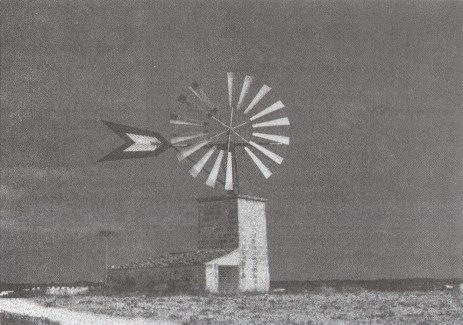
Ancient windmills in Majorca
That first afternoon in PALMA, as we were walking along a busy
street taking in all the sights, we happened to look up and we froze right there
on the spot. There in plain sight on the front of a building was one of those
fabulous red amber T-bars, still attached to a wire, but absolutely beautiful!
We couldn't believe it. We stood there transfixed, wondering how to get it down.
We finally realized "our insulator" wasn't going to go anywhere and
managed to tear ourselves away, but only after making sure we knew exactly where
to find it again.
Just a few streets over we saw two men perched high on
extension ladders leaning precariously against the front of a tall building.
Each man had a bucket, a hammer and chisel and a pot of wet putty. They were
removing the old insulators no longer in service! The hammer and chisel loosened the metal pins wedged into the wall, the bucket held the freed
insulators and the wet putty filled in the holes where they had been. When the
buckets were full, the men came down, emptied out the insulators and
moved the ladder over for the next climb. CAROL and I nabbed one of the men as
he descended. He happened to be the foreman and spoke fairly good English. He
and his fellow employee had been instructed to remove the insulators in order to
improve the appearance of the buildings. He pointed to a green van parked close by. Painted on the side was the word COBRA, which proved to be a small electric
company under contract to GAS Y ELECTRICIDAD S.A. GESA is the large public
utility in Palma that serves all of MAJORCA.
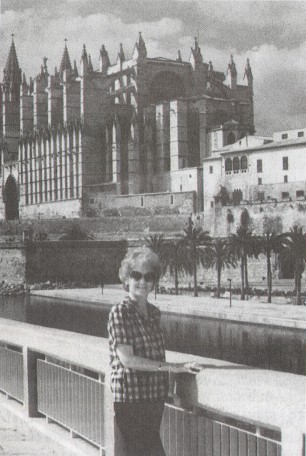
Marilyn admiring Palma Cathedral
The insulators in this man's bucket
proved interesting. One was a small white porcelain T-bar and the other was a
broken CD 680 in straw! He said we could have them. We showed him a photograph
of the one red amber CD 680 in captivity, explaining that we were most anxious
to find a few of these if he came across any, and pointing toward the street
where we had just seen one. He and his helper would be working in the area for a
couple more days and he promised to save any he found. He asked if we could come
back. COULD WE COME BACK??
Taking our leave, we drove to COBRA'S business
office, but they had nothing for us there and we were advised to go to their
service quarters where the men bring in their scrap insulators at the end of the
day. This we did and the manager there, SENOR TORO, gave us permission to go through the containers, but we found nothing particularly interesting.
Anything we might have wanted was either broken or firmly attached to metal
brackets and the whole lot was hopelessly tangled. Some of the men stared, but
not one came forth to help us so we gave up. SENOR TORO had told us that their
containers are taken to GESA'S storage yard or "garage" once a week
and dumped. We resolved to follow up on this lead because we were so close and
the adrenalin was flowing.
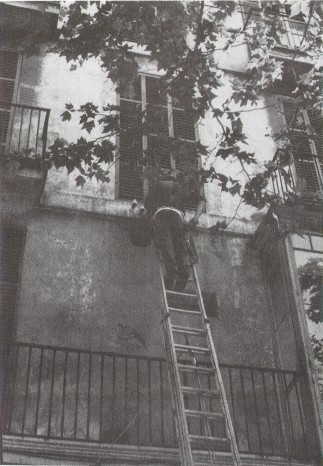
A Cobra worker removing insulators
It was late in the day so we left PALMA and drove along the beach front to
a resort area called EL ARENAL. There we found a very pleasant and inexpensive
hotel, the VERACRUZ GRAN BAHIA. It catered mainly to tour groups, but we were
welcomed and were able to get a good rate for the week, which included
breakfast. We were all set!
The next day we returned to PALMA and found our two
men again working up on their ladders. They still had nothing of interest for us
and were nearly through with their assignment on that particular street, but
they told us where they would be taking insulators down that afternoon. It
happened to be exactly where we had seen our little red amber T-bar the day
before. "Come back after lunch" they said.
We just had time to find
GESA' S business office, but when we got there, it was closed to the public for
the afternoon. Oh well, back to our friends with the buckets and ladders: We
waited...and waited...but they never came. In fact, we never saw them again the whole time we were in
MAJORCA. And our little CD 680 remained way up out of our reach. It had not been
as good a day as we'd hoped but we did enjoy some shopping and a look inside
PALMA CATHEDRAL with its impressive museum of gold and silver treasures.
We woke
up to rain the next morning, but being the dedicated collectors that we are, we
drove to GESA' S business office once again. This time the door was open.
One of their managers, DON PEDRO JAURVE, suggested we go to their storage yard
just a short distance away. He gave us a map and a note with his permission to
take any insulators we wanted. The man in charge, he said, was MR. JOSEPH
LUIS. DON PEDRO JAURVE also gave us the names of three supply houses in PALMA
where we could buy new insulators.
We found our man at GESA'S storage yard and
he spoke good English. He gladly took us out to the containers. There are not
words to describe the size and the number of those huge piles of insulators and
metal fixtures. JOSEPH LUIS looked at our photograph of CD 680 as we explained
our mission. He remembered seeing some bf them, but not very often. "These
are very old," he said. "They don't make them anymore, but you're
welcome to see what you can find."
Three other men came out to help us in
our search, one with a fork lift to move crates around for better access to
the insulators. SEBASTIAN is the only one whose name I can remember, but they
all dug just as enthusiastically as CAROL and I did through layer after layer of
scrap glass and porcelain. Together we found nine little white porcelain T-bars (sim.
U-2081) with the incuse trademark of MANUFACTURAS CERAMICAS S.A. in
Barcelona. The real thrill was finding nine CD 680's, three in red amber and six
in straw. They were unmarked, they were breathtaking and five were for sale.
CAROL couldn't resist adding a few common glass insulators marked E.S.A.
(ESPERANZA S.A. in Madrid) and some cast off electrical signs. We were soaked
with rain, but thank goodness for small problems. SEBASTIAN found a sturdy box
to hold our treasures and after many thank yous to these fellows, we drove away,
not quite believing our great success. Of course we had to stop at the three
supply houses and two of them had insulators to sell us -- a couple of unmarked
"spooks" in brown porcelain (sim. U-2061) and some E.S.A. glass - CD'S
372,373 and 523.
Once back at the hotel, we spread out all our loot and
luxuriated. Many pieces were still "with pin", so we set up pin
removal operations set on the balcony just outside our room. Because we'd
accomplished our mission in finding the CD 680'S, the stress level went down
considerably. Now, to see something of the island! We had three days left before returning
to Barcelona.
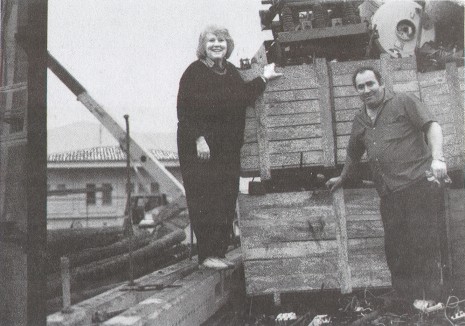
A triumphant Carol poses with Sebastian
We packed a lot into those three days. We drove east across
MAJORCA to see the famous beach in the resort city of PORTO CRISTO, found one
more CD 680 in red amber on the front of a house in LLUCHMAYOR and got someone
to take it down for us, went to MANACOR where the famous MALLORCA pearls are
made from sea shells, very carefully coaxed our little red FIAT up the mountain
road of many hairpin turns to the town of SOLLER on MAJORCA'S west side, enjoyed
the many fields of wildflowers and olive groves along the way, souvenir shopped
several times more, found the village of VALDEMOSA, where CHOPIN composed his
best sonatas from 1838-1839 while living in a cell at the CARTHUSIAN MONASTERY,
and-of course we took many pictures of insulators up on the poles.
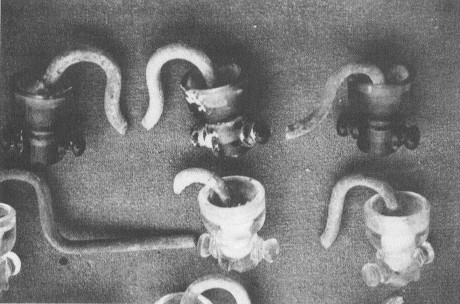
So me of our precious haul -- CD 680's
On Monday,
May 14th, insulators all packed along with a few articles of clothing (first
things first!), CAROL and I checked in our rental car and flew back to Barcelona
for another night at the ALPHA HOTEL. CAROL'S flight left early the next morning
-- SWISSAIR to Zurich, then KLM to Amsterdam to Chicago. A few hours later, KLM
took me right to Amsterdam, then to Houston. Barring a couple of mishaps, it was
a wonderful trip and we have many fond memories, plus quite a bit of new information on manufacturers, and many treasured pieces for our collections,
including some new CD and U-numbers. But it was very good to get home again.
It's been a pleasure sharing our story with you. The only really hard part was
trying to condense it without losing some of the color. We hope you enjoyed it,
too!
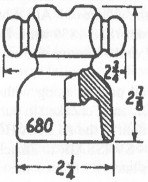 |
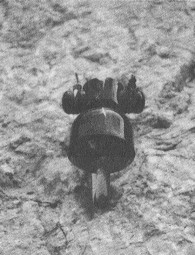
A red amber CD 680 still up on the wall! |
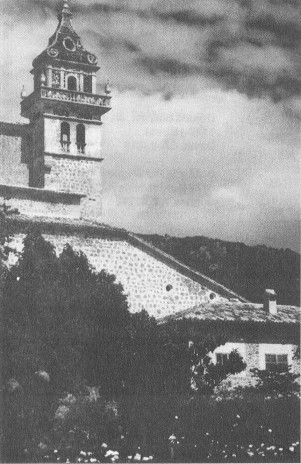
Carthusian Monastery -- Chopin's home for a year.
(Editor's note: It seems that over the five years that I have edited Crown
Jewels of the Wire, the articles which received the most comments and responses
from you readers have been those that involved the "adventures" of our
collectors. The "Richmond Dig", "Humongous Buying Trip of Mikey
and Billy", and this five-part series about the four and one half week trip
that Marilyn and I took last year have brought enthusiastic reviews. I want to
personally thank Marilyn for giving much time and effort to each of these
articles and for relinquishing valuable magazine space from her bi-monthly
column to share "our" adventure.
I encourage you all who own glass
foreign insulators to contact Marilyn and Woody with variations in color,
embossing and possible unidentified CD styles so that their long-awaited foreign
book (due this fall) will be published on time. I, for one, need to have that
book to identify those goodies that Marilyn had me pack for shipping and carry
back from Europe!
Thanks again, Marilyn, for a wonderful experience --- the
pleasure of your company, the thirst for adventure, the enthusiasm and knowledge
you shared about the glass and porcelain we brought home! Next time, we get a
better map and a car that is impervious to those honking at us to "turn
around, you're on a one way street, going the wrong way!" And let's take
Bill and John along with a ladder and their muscles to lug those insulators from
the car to our room each night so we could play "Insulator - Go Fish."
"Do you have this one?" "No. Go Fish!!"
| 